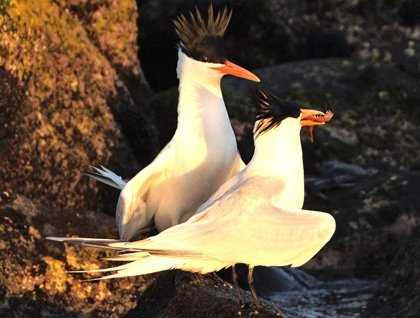Enthusiastic photographers bounced towards shore early in the morning with the purpose of capturing a few sunrise shots. Yellow-footed gulls called as we made our way along a shoreline full of baseball-sized rocks. Usually round nests of seaweed line the shore just above the high tideline. This year seemed to be a late one for nesting. The diffuse morning light helped photographers capture images of the endemic hedgehog cactus.
Later in the morning we hiked into the long arroyo that crosses most of the four-mile width of this mountainous island. The highlight for most of us was a chance to see the endemic pinto chuckwalla. This pudgy, low-slung creature has a peachy-orange body speckled with dark, light gray, and tan splotches. They are so well camouflaged that anyone finding one is rewarded, especially by the very wide smile-like expression.
Aerobic hikers traveled over halfway across the island, while interpretive walkers looked for lizards, birds, and desert plants. Many large cardon cactuses had beautiful white blossoms still open from the night’s pollination by bats. Insects buzzed about before the flowers closed. Dark burgundy berries drooped from heavily laden shrubs called tintas.
The National Geographic Sea Bird headed for Isla Rasa for an afternoon of birds. The island is home to hundreds of thousands of elegant and royal terns and Heermann’s gulls when there is enough food for them. Last year was a poor year for schooling fish in the Gulf of California, and no terns nested successfully here. Our hopes of a better season came true as we approached the island. A pair of elegant terns made a choreographed flight over the ship in formation, calling as they descended. Thousands of birds were flying and calling, displaying and bathing. We enjoyed great views of these remarkable birds flying into the setting sun as today’s photograph shows. Cameras clicked a thousand photos as a beautiful sunset lit our way home.







